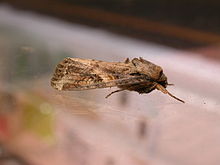| Fall armyworm | |
|---|---|

| |

| |
| Scientific classification | |
| Domain: | Eukaryota |
| Kingdom: | Animalia |
| Phylum: | Arthropoda |
| Class: | Insecta |
| Order: | Lepidoptera |
| Superfamily: | Noctuoidea |
| Family: | Noctuidae |
| Genus: | Spodoptera |
| Species: | S. frugiperda
|
| Binomial name | |
| Spodoptera frugiperda (J. E. Smith, 1797)
| |
The fall armyworm (Spodoptera frugiperda) is a species in the order Lepidoptera and one of the species of the fall armyworm moths distinguished by their larval life stage. The term "armyworm" can refer to several species, often describing the large-scale invasive behavior of the species' larval stage. It is regarded as a pest and can damage and destroy a wide variety of crops, which causes large economic damage. Its scientific name derives from frugiperda, which is Latin for lost fruit, named because of the species' ability to destroy crops.[1] Because of its propensity for destruction, the fall armyworm's habits and possibilities for crop protection have been studied in depth. It is also a notable case for studying sympatric speciation, as it appears to be diverging into two species currently.[2] Another remarkable trait of the larva is that they consistently practice cannibalism, despite its fitness costs.[3][4]
The fall armyworm is active at a different time of year from the true armyworm, another species in the order Lepidoptera and family Noctuidae, but of the genus Mythimna. Outbreaks of the true armyworm usually occur during the early part of the summer; the fall armyworm does most damage in the late summer in the southern part of the United States, and early fall in the northern regions.[5]
- ^ McLeod, Robin (October 21, 2017). "Species Spodoptera frugiperda - Fall Armyworm Moth - Hodges#9666". BugGuide. Retrieved October 15, 2020.
- ^ Groot, Astrid T.; Marr, Melanie; Heckel, David G.; Schöfl, Gerhard (2010-01-01). "The roles and interactions of reproductive isolation mechanisms in fall armyworm (Lepidoptera: Noctuidae) host strains". Ecological Entomology. 35: 105–118. doi:10.1111/j.1365-2311.2009.01138.x. ISSN 1365-2311. S2CID 83674920.
- ^ Van Allen, Benjamin G.; Dillemuth, Forrest P.; Flick, Andrew J.; Faldyn, Matthew J.; Clark, David R.; Rudolf, Volker H. W.; Elderd, Bret D. (2017). "Cannibalism and Infectious Disease: Friends or Foes?". The American Naturalist. 190 (3). University of Chicago Press: 299–312. doi:10.1086/692734. hdl:1911/97826. ISSN 0003-0147. PMID 28829639. S2CID 3905739.
- ^ Chapman, J. W. (1999-05-01). "Fitness consequences of cannibalism in the fall armyworm, Spodoptera frugiperda". Behavioral Ecology. 10 (3). Oxford University Press (OUP): 298–303. doi:10.1093/beheco/10.3.298. ISSN 1465-7279.
- ^ Luginbill, Philip (February 1928). "The Fall Army Worm". Technical Bulletin (U.S. Dept. Of Agriculture. Bureau of Entomology) (34).